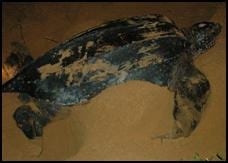Specimen of the Week: Week Twenty-Five
By Emma-Louise Nicholls, on 2 April 2012
 The species that this week’s specimen of the week belongs to is huuuuuuuuuuuuge. The specimen we have in the museum however is teeny tiny, at least by comparison. It is a hatchling and ridiculously cute. The use of the word ‘hatchling’ to describe the juvenile of this species should have you wandering down the right taxonomic path, if still in a very vague direction. So let me help you out, this week’s specimen of the week is…
The species that this week’s specimen of the week belongs to is huuuuuuuuuuuuge. The specimen we have in the museum however is teeny tiny, at least by comparison. It is a hatchling and ridiculously cute. The use of the word ‘hatchling’ to describe the juvenile of this species should have you wandering down the right taxonomic path, if still in a very vague direction. So let me help you out, this week’s specimen of the week is…
**!!!The Leatherback turtle!!!**
1) The leatherback turtle is the world’s largest turtle-tortoise-type-creature species, even beating the famous Galapagos giant tortoise, despite its boastful name. They grow up to 1.6 m and the heaviest on record weighed a ridiculous 916 kg. Unlike other turtles and tortoises, the shell is flexible rather than rigid, and has a thin layer of leathery skin over it, earning it the name ‘leatherback turtle’.
2) Leatherbacks eat soft-bodied animals. Jellyfish seem to be a favourite. Thousands of plastic bags get thrown/are blown/through-our-lazy-and-inept-disposal-techniques-end up in… the sea and unfortunately, to a turtle they look quite a lot like jellyfish. Resemble jellyfish they may, but taste like them they do not. Nor do they digest like them, and leatherback turtles are suffocating in such great numbers that they are now critically endangered. Take home message? Plastic bags = bad.
3) Reptiles cannot regulate their own body temperature and thus require external heat sources, such as the sun, to get them out of bed in the morning. Leatherback turtles however are exceptionally talented and can maintain a slightly elevated body temperature due to a blood supply system that is both complicated and genius. This genius idea of evolution’s allows leatherback turtles to swim in the colder waters found at depths of over 1,000 m where they hunt for prey.

This image shows the inside of the throat of a leatherback turtle. Perfect for preventing slippery jellyfish from sliding out.
4) Despite their enormous size, in order to lay their eggs female leatherbacks will only leave the water in the dead of night. They dig a deep hole with their rear flippers and deposit up to 100 eggs into it. As with crocodiles, the incubation temperature alters the sex of the babies. Warmer nest sites will induce females, whereas cooler nests produce all males.
5) The leatherback turtle inhabits waters as far north as Alaska and as far south as South Africa. They will only nest in the tropics however. Given that cold nests = male hatchlings, presumably nesting in colders areas would be detrimental to the species’ survival…
One Response to “Specimen of the Week: Week Twenty-Five”
- 1
 Close
Close




Fantastic epic journey they make… I wish I could see them one day… in their natural habitat… don’t think there are many on the North West Coast of he UK unfortunately!